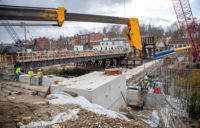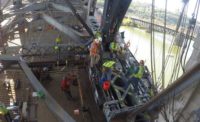One of the largest bridges ever built over the Danube River will officially open between Bulgaria and Romania early next month after decades of planning and lengthy construction delays.
The 1,391-meter-long road-rail bridge project survived not only tough physical conditions but also the sometimes chaotic transition of the host countries from communism to membership in the European Union.
From near Calafat, Romania, the so-called Danube Bridge 2's cable-supported deck crosses three 180-m-wide navigations channels, with 115-m-long and 124-m-long side spans.
Seven 80-m-long and one 52-m-long concrete box girder spans complete the crossing to the Bulgarian abutment near Vidin, where the highway runs onto a long embankment. The railroad track splits from the road and continues for 400 m on a viaduct.
The main contractor, FCC Construcción, S.A., Madrid, is still putting the finishing touches on its imposing structure in time for the May 9 ribbon cutting by José Manuel Barroso, the European Commission president. The bridge was originally due for completion in April 2010.
Of the four main reasons for delay cited by FCC's project design manager, José Ignacio Díaz de Argote, three relate to bureaucracy. The fourth cause concerns the late discovery of poor ground conditions under embankments.
Disruption from permitting and legislation changes might be unusual in Western Europe, but it comes as little surprise to Vardaman Jones, a director of the London-based design firm High-Point Rendel.
Working with the French design firm Ingérop S.A., Courbevoie, High-Point Rendel oversees the project's design and construction for the Bulgarian Ministry of Transport, Information Technology and Communications.
Developing the project in a period of intense political and economic transition was “a huge task for the countries,” says Jones. For example, even when the Bulgarian government hired international engineers to produce bidding designs in 2003, matters of land ownership had yet to be fully resolved.
Bulgaria and Romania began planning the project more than 20 years before the 1989 fall of the Berlin Wall, which set the countries on a path to EU membership in 2007.
Germany paid for initial environmental studies that began 12 years ago, and the EU financed initial design work with a special fund to prepare ex-communist countries for EU membership.









Post a comment to this article
Report Abusive Comment